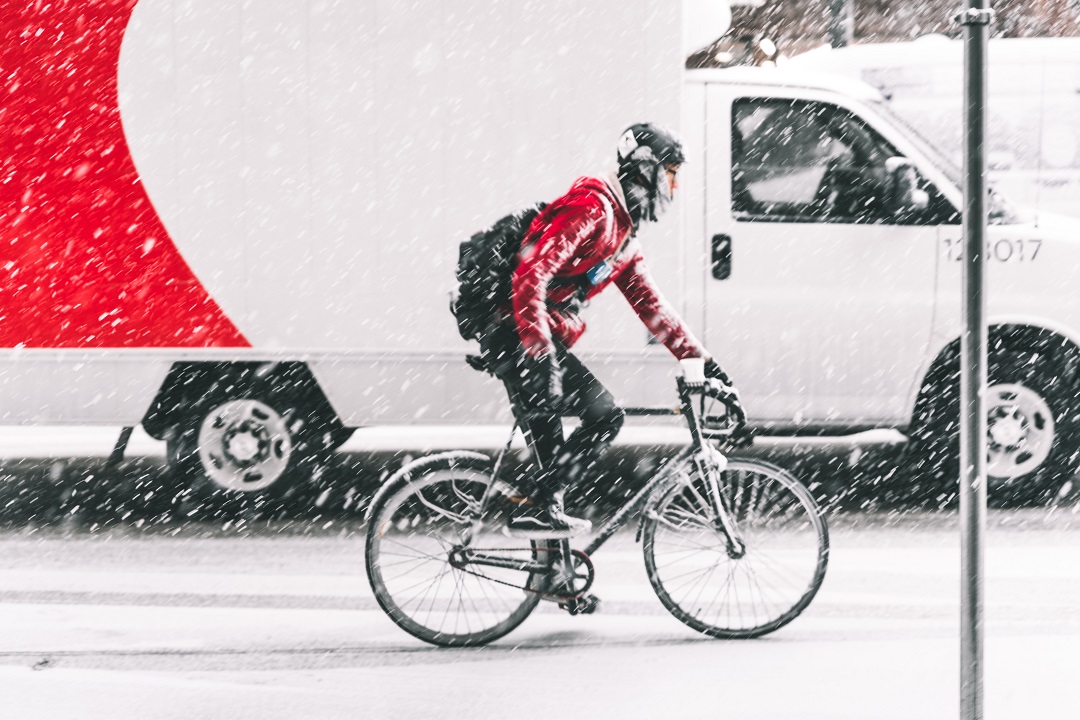- Tips and tricks for bicycling in winter.
- Local experts provide advice for cycle warmth and safety.
Facing down the pandemic quarantine last spring, cycling was my favorite way to cope. I had plenty of company — the roads and trails were filled with people eager to get out of the house, whether they were new to biking or seasoned cyclists. I loved interacting with other humans, albeit at a safe social distance.
As winter settles in, cycling is still my favorite escape. Toiling away alone on the bike trainer in the basement holds zero appeal for me. I crave the fresh air and freedom of riding outside. Plus, it is a great calorie burner.
“Riding is good for you anytime, but you’ll use more energy staying warm in the winter,” said Tony Blackwood, owner of South Side Cyclery in south St. Louis.
“We need to be creative in figuring out ways to maintain our sanity and health,” said Elena Claus Friedman, medical coordinator for the Missouri Interscholastic Cycling League. “Getting outside for some sunshine and vitamin D is a great way to clear the head and stave off the winter doldrums. Avoiding isolation is huge, and this is a way to connect.”
Dress in Layers
Riding in winter can often feel experimental. Gear that you can adjust to deal with changing conditions and temperature works best. Layers are key to keeping your core warm.
“Start with a base layer made of merino wool or a synthetic fabric to pull water away from your skin,” said John Davis, product manager at Maplewood Bicycle.
There is plenty of high-tech cycling clothing for cold weather, but you don’t have to spend a fortune.
“Most people already have stuff in the house they can use,” said Ed Foster, owner of Sunset Cyclery. If you have a long-sleeve technical shirt, that’s perfect.” Add one or two layers you can shed as you warm up, and a windbreaker.
“You want to fight the wind chill,” said Davis. “All of our jackets have windproof fronts and breathable backs.”
Foster likes convertible jackets with zip-off arms, like the Specialized Deflect Hybrid. “It’s a jacket and a vest for the same investment. I can ride down to 40 degrees in this. When the sun is warm, I’ll stop and unzip the arms.”
Layers work for legs, too. You may already have long johns or tights that you can wear over bike shorts. “For anything under 55 degrees, cover your knees for the fluid and the movement,” said Davis.
Capris are popular, or try knee warmers that you can peel off. You can also layer knee warmers over tights when it is really cold outside.
Toasty Hands and Feet
Keeping your core warm is the first step for warm hands. Next comes gloves, and the weights vary.
“You want something that’s not overly thick, so you can use your brakes and shifters,” said Davis. “It should be easy on, easy off and not too tight around your wrist.”
Pogies or bar mitts are ideal when it’s freezing. The insulated pockets attach to your handlebar, creating a microclimate for your hands. For a lower budget option, try hand warmers.

The author on the Katy Trail in wintertime.
For warm feet, start with wool socks and add something to shield your feet from the wind. “You can wear a toe cover or a full shoe cover to cut the wind chill on the road,” said Davis.
“Toe warmers are my go-to winter gear item,” said Friedman. “I put them over my sock, stick my foot in a plastic shopping bag and then put my shoes on.” Covering the cleat openings inside your shoes with duct tape also helps keep out the cold.
Cycling boots are the ultimate choice for extreme cold, but they can cost hundreds of dollars. If you ride flat pedals, you might already have boots that work.
Heat Your Head
Insulated headbands or beanies will keep your ears and noggin warm. Multifunctional gear like balaclavas and neck gaiters or tubes (buffs) can be adjusted as conditions change.
“A tube can cover you from your spine to your skull. You can pull it down on your neck or pull it off,” said Davis.
“If it’s real cold, you want some kind of face shield,” said Blackwood. “At 40 degrees, I wear a balaclava with cut-outs for the eyes and nose.”
Staying Safe
“When it’s freezing, you still need to hydrate, so have a plan,” Friedman said. “That may mean wearing your Camelbak inside your coat and getting an insulating sleeve for the tube.”
Insulated water bottles can also keep your water liquid longer.
“Make a plan to change into warm dry clothing after the ride,” Friedman adds. “You can become hypothermic pretty quickly.”
“You should run lights all the time — front and rear, day or night,” Davis added. “Look for an irregular flash pattern. It confuses the brain, so drivers notice it.” At night, a headlamp with 500 lumens or more will help you spot road debris.
Enjoy the Ride
A ride does not need to be long to lighten your mood. “There’s no shame in riding shorter distances,” said Foster. “Eight miles is better than no miles.”

Snow on Grant’s Trail in south St. Louis County.
Mountain bike trails where the trees block the wind are popular in the winter. If you ride a road or hybrid bike, head to a greenway with windbreaks along creeks and wooded areas. Some good places to start are the Busch Greenway near the Katy Trail and the Al Foster and Rock Hollow trails on the Meramec Greenway.
“I think it’s going to be an active winter,” Foster said. “We’re going to see a lot of new people who have been introduced to the sport and are enjoying it.”
Author: Janice Branham is a regular contributor to Terrain Magazine.


Leave A Comment